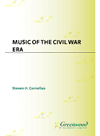
Music of the Civil War Era PDF
Preview Music of the Civil War Era
Music of the Civil War Era Recent Titles in American History through Music David J. Brinkman, Series Editor Music of the Counterculture Era James E. Perone Music of the Civil War Era Steven H. Cornelius American History through Music David J. Brinkman, Series Editor GREENWOOD PRESS Westport, Connecticut • London Library of Congress Cataloging-in-Publication Data Cornelius, Steven, 1952- Music of the Civil War era / Steven H. Cornelius. p. cm.—(American history through music) Includes bibliographical references and index. ISBN 0-313-32081-0 (alk. paper) 1. United States—History—Civil War, 1861-1865—Music and the war. 2. Music— United States—19th century—Social aspects. I. Title. II. Series. ML3551.4.C67 2004 7801.973*09034—dc22 2004042531 British Library Cataloguing in Publication Data is available. Copyright © 2004 by Steven H. Cornelius All rights reserved. No portion of this book may be reproduced, by any process or technique, without the express written consent of the publisher. Library of Congress Catalog Card Number: 2004042531 ISBN: 0-313-32081-0 First published in 2004 Greenwood Press, 88 Post Road West, Westport, CT 06881 An imprint of Greenwood Publishing Group, Inc. www.greenwood.com Printed in the United States of America ® The paper used in this book complies with the Permanent Paper Standard issued by the National Information Standards Organization (Z39.48-1984). 10 9 8 7 6 5 4 3 21 For my great-great-great-uncle Casper A. Kessenich, my grandfather Harry E. Kessenich, and my father Rupert G. Cornelius. BEAT! BEAT! DRUMS! Beat! beat! drums!—Blow! bugles! blow! Through the windows—through doors—burst like a force of ruthless men, Into the solemn church, and scatter the congregation; Into the school where the scholar is studying: Leave not the bridegroom quiet—no happiness must he have now with his bride; Nor the peaceful farmer any peace, plowing his field or gathering his grain; So fierce you whirr and pound, you drums—so shrill you bugles blow. Beat! beat! drums!—Blow! bugles! blow! Over the traffic of cities—over the rumble of wheels in the streets: Are beds prepared for sleepers at night in the houses? No sleepers must sleep in those beds; No bargainers' bargains by day—no brokers or speculators—Would they continue? Would the talkers be talking? would the singer attempt to sing? Would the lawyer rise in the court to state his case before the judge? Then rattle quicker, heavier drums—you bugles wilder blow. Beat! beat! drums!—Blow! bugles! blow! Make no parley—stop for no expostulation; Mind not the timid—mind not the weeper or prayer; Mind not the old man beseeching the young man; Let not the child's voice be heard, nor the mother's entreaties; Make even the trestles to shake the dead, where they lie awaiting the hearses, So strong you thump, O terrible drums—so loud you bugles blow. —Walt Whitman, Drum-Taps Contents Series Foreword ix Preface xi 1. Antebellum America l 2. Music in Everyday Life 25 3. African Americans in Civil War Music 117 4. Urban and Concert Music 157 5. The War's End, and Forward 215 6. Musicians of the Civil War Era 231 7. Dictionary of Civil War-Era Music 243 Notes 251 Bibliography 269 Song Index 281 Subject Index 287 This page intentionally left blank Series Foreword The elements of music are well known. They include melody, rhythm, har mony, form, and texture. Music, though, has infinite variety. Exploring this variety in the music of specific time periods, such as the Colonial and Rev olutionary Period, the Roaring Twenties, and the Counterculture Era, is the purpose of the "American History through Music" series. The authors of each volume describe the music in terms of its basic elements, but more importantly, focus on how the social, economic, political, technological, and religious influences shaped the music of that particular time. Each volume in the series not only describes the music of a particular era but the ways in which the music reflected societal concerns. For these purposes, music is defined inclusively; this series considers such diverse musical genres as classical, folk, jazz, rock, religious, and theater music, as each of these genres serve as both reflections of society and as illustrations of how music influ ences society. Perhaps the most important conclusion that readers will draw from this series is that music does not exist independently of society. Listeners have enjoyed music throughout time for its aesthetic qualities, but music has also been used to convey emotions and ideas. It has been used to enhance pa triotic rituals, and to maintain order in social and religious ceremonies. The "American History through Music" series attempts to put these and other uses of music in an historical context. For instance, how did music serve as
